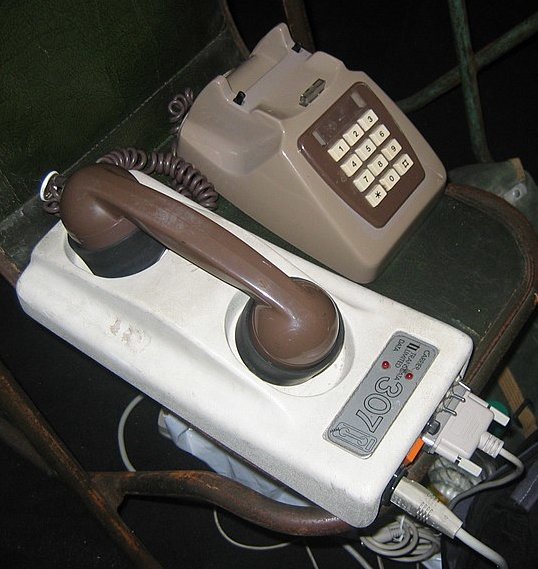
Modem
A modulator-demodulator or modem is a computer hardware device that converts data from a digital format into a format suitable for an analog transmission medium such as telephone or radio. A modem transmits data by modulating one or more carrier wave signals to encode digital information, while the receiver demodulates the signal to recreate the original digital information. The goal is to produce a signal that can be transmitted easily and decoded reliably. Modems can be used with almost any means of transmitting analog signals, from light-emitting diodes to radio.
"Computer modem" redirects here. Not to be confused with Computer Modern.
Early modems were devices that used audible sounds suitable for transmission over traditional telephone systems and leased lines. These generally operated at 110 or 300 bits per second (bit/s), and the connection between devices was normally manual, using an attached telephone handset. By the 1970s, higher speeds of 1,200 and 2,400 bit/s for asynchronous dial connections, 4,800 bit/s for synchronous leased line connections and 35 kbit/s for synchronous conditioned leased lines were available. By the 1980s, less expensive 1,200 and 2,400 bit/s dialup modems were being released, and modems working on radio and other systems were available. As device sophistication grew rapidly in the late 1990s, telephone-based modems quickly exhausted the available bandwidth, reaching 56 kbit/s.
The rise of public use of the internet during the late 1990s led to demands for much higher performance, leading to the move away from audio-based systems to entirely new encodings on cable television lines and short-range signals in subcarriers on telephone lines. The move to cellular telephones, especially in the late 1990s and the emergence of smartphones in the 2000s led to the development of ever-faster radio-based systems. Today, modems are ubiquitous and largely invisible, included in almost every mobile computing device in one form or another, and generally capable of speeds on the order of tens or hundreds of megabytes per second.
Overall history[edit]
Modems grew out of the need to connect teleprinters over ordinary phone lines instead of the more expensive leased lines which had previously been used for current loop–based teleprinters and automated telegraphs. The earliest devices that satisfy the definition of a modem may be the multiplexers used by news wire services in the 1920s.[1]
In 1941, the Allies developed a voice encryption system called SIGSALY which used a vocoder to digitize speech, then encrypted the speech with one-time pad and encoded the digital data as tones using frequency shift keying. This was also a digital modulation technique, making this an early modem.[2]
Commercial modems largely did not become available until the late 1950s, when the rapid development of computer technology created demand for a method of connecting computers together over long distances, resulting in the Bell Company and then other businesses producing an increasing number of computer modems for use over both switched and leased telephone lines.
Later developments would produce modems that operated over cable television lines, power lines, and various radio technologies, as well as modems that achieved much higher speeds over telephone lines.
Leased-line modems[edit]
A leased line modem also uses ordinary phone wiring, like dial-up and DSL, but does not use the same network topology. While dial-up uses a normal phone line and connects through the telephone switching system, and DSL uses a normal phone line but connects to equipment at the telco central office, leased lines do not terminate at the telco.
Leased lines are pairs of telephone wire that have been connected together at one or more telco central offices so that they form a continuous circuit between two subscriber locations, such as a business' headquarters and a satellite office. They provide no power or dialtone - they are simply a pair of wires connected at two distant locations.
A dialup modem will not function across this type of line, because it does not provide the power, dialtone and switching that those modems require. However, a modem with leased-line capability can operate over such a line, and in fact can have greater performance because the line is not passing through the telco switching equipment, the signal is not filtered, and therefore greater bandwidth is available.
Leased-line modems can operate in 2-wire or 4-wire mode. The former uses a single pair of wires and can only transmit in one direction at a time, while the latter uses two pairs of wires and can transmit in both directions simultaneously. When two pairs are available, bandwidth can be as high as 1.5 Mbit/s, a full data T1 circuit.[52]
While the slower leased line modems used, e.g., RS-232, interfaces, the faster wideband modems used, e.g., V.35.
Short-haul modem[edit]
A "short haul modem" is a device that bridges the gap between leased-line and dial-up modems. Like a leased-line modem, they transmit over "bare" lines with no power or telco switching equipment, but are not intended for the same distances that leased lines can achieve. Ranges up to several miles are possible, but significantly, short-haul modems can be used for medium distances, greater than the maximum length of a basic serial cable but still relatively short, such as within a single building or campus. This allows a serial connection to be extended for perhaps only several hundred to several thousand feet, a case where obtaining an entire telephone or leased line would be overkill.
While some short-haul modems do in fact use modulation, low-end devices (for reasons of cost or power consumption) are simple "line drivers" that increase the level of the digital signal but do not modulate it. These are not technically modems, but the same terminology is used for them.[68]